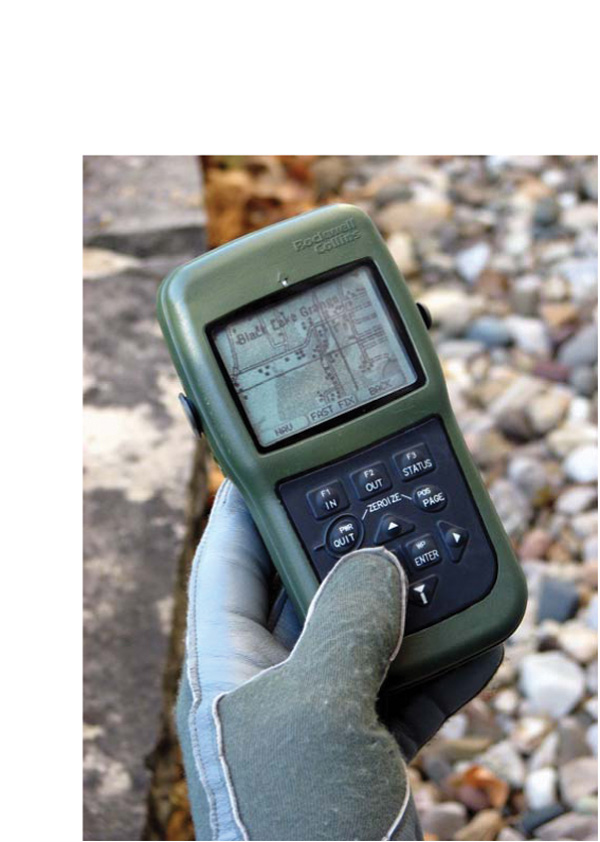 DAGR 2008. Rockwell Collins image
DAGR 2008. Rockwell Collins imageDevelopment and acquisition of military GPS user equipment (MGUE) are taking on new dimensions across the board — institutionally, procedurally, and technologically.
Along the way, the changes could redefine relationships within the Department of Defense (DoD) and between the agency and industry.
At the agency level, a proposal is forthcoming to “stand up” a positioning, navigation, and timing (PNT) user equipment joint program office (JPO) that would incorporate UE responsibilities (and budgets) now exercised by the GPS Wing (GPSW).
Development and acquisition of military GPS user equipment (MGUE) are taking on new dimensions across the board — institutionally, procedurally, and technologically.
Along the way, the changes could redefine relationships within the Department of Defense (DoD) and between the agency and industry.
At the agency level, a proposal is forthcoming to “stand up” a positioning, navigation, and timing (PNT) user equipment joint program office (JPO) that would incorporate UE responsibilities (and budgets) now exercised by the GPS Wing (GPSW).
At the product level, end user equipment would take on more application-specific, “friendlier” features that support the distinct conditions of military operating environments. Tying these elements together, the Air Force is working to develop a “flexible” acquisition approach that will allow development of a “family of receiver solutions.”
Along the way, the DoD is trying to catch up with technical advances in consumer products, align equipment development timelines with those of the space and operational control segments, and accommodate customer demands from the various branches and service personnel in the field.
The target of the technology effort would be a common GPS module (CGM) that emulates the commercial development paradigm by focusing on a GPS engine with which product integrators can build applications, according to an April 16 brief by Col. Don Wussler, GPSW vice commander, speaking at a Space and Missile Systems Center industry day at Los Angeles Air Force Base.
Initial contracts would deliver a module and a CGM-based card. The CGM itself would be incorporated into lead platforms chosen by the various branches and hundreds of mission-specific applications.
The CGM-based card is intended for than 70,000 ground-embedded platforms — tanks, personnel carriers, and so forth. MGUE would follow on the GPS modernized user equipment (MUE) acquisition now under way.
The Way Things Are
Three vendors — L3/Interstate, Rockwell Collins, and Raytheon — currently are working on MUE technology demonstration contracts from the GPS Wing. Prototype hardware deliveries begin in early Fiscal Year 2010 (FY10).
According to testimony by Maj. Gen. Neil McCasland, director of space acquisition for the Office of the Secretary of Defense, at a May 7 congressional hearing, all three vendors are developing prototype hardware capable of receiving new and existing GPS signals, and each has conducted a critical design review.
"Based on the technology demonstration work, our approach to MGUE development and integration will emphasize modularity in the design to enable integration into the large number of end user applications and platforms. Available in 2015, these lighter, faster new receivers will be reprogrammable and include security and jam-resistant improvements," McCasland said.
In a May 14 presentation to the National Space-Based PNT Executive Committee Advisory Board, Brig. Gen, John Hyten, the Air Force Space Command (AFSPC) director of requirements, said that an MGUE requirements document entered staffing in May, co-authored by AFSPC and the individual military services.
End user equipment requirements are being documented in operational domains (ground, air, maritime, and space) and will go through an approval process concurrent with an updated GPS III capabilities development document (CDD).
The GPSW would retain responsibility for developing specifications — including a GPS Wing–owned, nonproprietary operating interface — and delivering a baseline CGM. The wing would pay for a limited number of companies to develop the core modules, certify the security components, provide engineering assistance, and oversee technology maturation.
In line with the president’s recent budget proposals, an Air Force research, development, test, and evaluation (RTD&E) “justification” document for MGUE expenditures released in May calls for $80 million in FY09 spending for the MGUE program and $77 million in FY10.
The FY08 expenditure amounted to $106.5 million. Budget for the MGUE effort continues the Y-code/M-code/coarse-acquisition (YMCA) proof-of-concept development initiated with the earlier and ongoing modernized user equipment (MUE) program.
However, large-scale production of the CGM is not scheduled to take place until FY15. That timeline underlies a good deal of the emphasis given by a recent Government Accountability Office (GAO) for the Air Force to better “synchronize” the space, ground, and user equipment aspects of the GPS program.
The Way Things Were
In the past, the GPSW’s predecessor organization, the GPS JPO, oversaw creation of platform-specific equipment such as the miniaturized airborne receiver (MAGR), combat survivor-evader locator (CSEL, for rescue of downed pilots), and the handheld defense advanced GPS receiver (DAGR).
A later generation of equipment added more OEM-like form factors including the ground-based GPS receiver application module (GB-GRAM) and the GPS receiver application module–standard electronics module (GRAM-SEM), with the JPO offering development contracts rather than production contracts.
On April 30, Rockwell Collins announced that it had delivered its 300,000th DAGR and recently received a $450 million follow-on contract to provide more of the receivers through 2016.
Despite this widespread availability, however, the DAGR has come in for considerable criticism in recent statements by DoD officials and at the GPS Partnership Council meeting held in early May, reflecting dissatisfaction expressed by soldiers in the field. The complaints reportedly revolve around the number of buttons that need to be pushed while watching the DAGR display in order to get a position fix.
Such sentiments are driven on one hand by technology innovations in commercial and consumer GPS products that have outstripped the more deliberate and bureaucratic processes of DoD acquisition and, on the other, by military users’ familiarity with these consumer products.
The picture of a foot soldier dashing down an Iraqi street or up an Afghan hillside with a rifle in one hand and a Garmin or TomTom unit in the other is no longer the fantasy of a marketing director but daily reality.
The Way Things May Be
Moving further from the one-size-fits-all tendencies of past acquisitions, the new approach appears likely to place acquisition officials in the various services in a stronger position to specify branch-specific needs and equipment designs. Companies would use the operating interface to build products under contracts with the services.
Conceivably, such an approach could widen the number of companies participating in MGUE production beyond the traditional DoD suppliers already involved in military UE programs. (Wussler’s SMC industry day presentation featured the logos of Garmin and TomTom as examples of commercial integrators.)
However, such companies would need to meet the security verification and domestic manufacturing requirements for DoD equipment, as well as the very different contracting processes and timelines of military buyers.
An industry source indicated that GPSW leaders may even be thinking in terms of an intellectual property (IP) licensing approach to future GPS technology acquisition, such as is common in GPS consumer application markets.
As for the concept of a PNT JPO, the initiative is supported by the Office of the Assistant Secretary of Defense for Networks and Information Integration (ASD/NII), which was designated by the Deputy Secretary of Defense as the authority responsible for all aspects of GPS. This new entity would restore the multi-service nature of the acquisitions agency under the GPS JPO, which became a predominately Air Force–led effort as the GPS Wing.
Broadening the focus from GPS to PNT also reflects the AFSPC restructuring last year to create a series of “command leads” headed by colonels, including a PNT command lead rather than a GPS command. (A 2004 presidential national security directive had previously replaced the Interagency GPS Executive Board with the Space-Based PNT Executive Committee.) And it aligns with the ongoing effort to create a National PNT Architecture strategy, with proposals expected in August for civil and DoD implementation plans.





